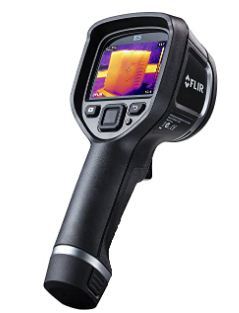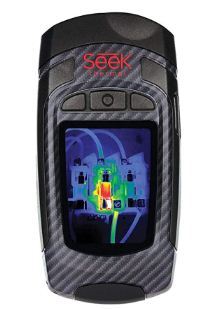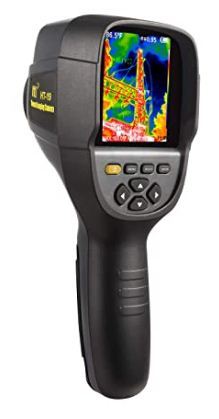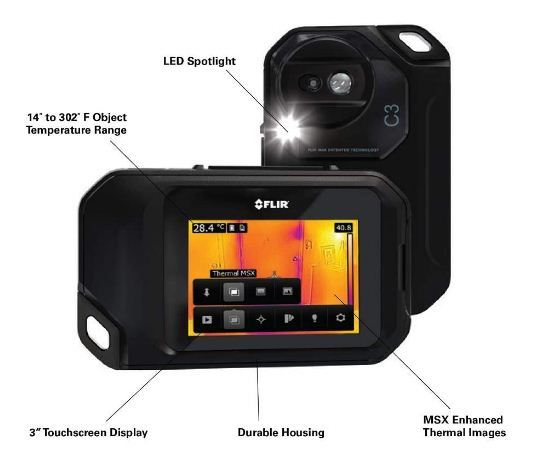Looking for a thermal camera to detect HVAC and water leaks?
You've come to the right place.
As a homeowner, you can save a significant amount of money by inspecting your property for energy loss and thermal leaks around the house - but you can only deal with them once you know where they are.
This is where thermal imaging cameras for leak detection come in. If you hire a professional inspector, this is what they will use to identify issues.
The good news today is that thermal imaging cameras capable of detecting leaks are now very affordable, so you can bypass hiring or paying for inspections and do them yourself.
It’s impossible to see most thermal leaks with the naked eye, but thermal cameras and imagers can spot cold/hot spots in your home within seconds.
What's In This Guide?
In this buying guide we compare and review the best thermal imagers you can buy for leak detection in a home.
Many of these will work just as well in a commercial or industrial setting. But we do not review high-end commercial imagers in this guide.
If you prefer a smartphone-based option, check out our reviews of thermal imagers for your smartphone.
If you need a dedicated thermal imager on a limited budget, then take a look at our reviews of the cheap thermal imaging cameras.
Top 5 Thermal Imaging Camera for Water Leak Detection
Disclaimer: All links below go to Amazon.com
PerfectPrime IR001
Best for Multiple Uses
Temperature Range:
-20 to 300°C
FLIR E5 Thermal Imaging Camera
Best for the Money
Temperature Range:
20°C to +250°C
Seek Thermal RevealPro
Best for Convenience
Temperature Range:
-40F° to 626°F
HTI-Xintai HTI-19 Infrared Thermal Camera
Best for Beginners
Temperature Range:
-20°C to 300°C
Warranty:
Money-back guarantee
FLIR Pocket Thermal Camera
Best in Portability
The IR001 is a great option for both homeowners and technicians. It is extremely affordable, easy to use, highly efficient, and quite precise, too. Plus, it is quite versatile and can be used for several purposes. Thus, it is ideal for both residential and professional needs.
Pros
- Works fairly quickly and fluidly displays data.
- Lightweight and easy to use.
- Comes with a plethora of features.
- Also allows you to store and delete photos and videos.
- Long battery life.
- Features ¼-inch standard screws to place. the camera on a tripod.
Cons
- Poor resolution.
- Overlay camera and infrared sensor are out of sync .
Our Review
The PerfectPrime IR001 comes with a 2.4-inch full HD screen that ensures detailed and precise image data.
The screen refresh rate is excellent, and the thermal imager converts the reading into visual images that you can understand easily.
The 4GB microSD card in the thermal imager stands means you can capture and store videos and photos on the go. It even allows you to recover deleted files in case you want to refer to them later.
The remote sensing function is also fairly accurate.
Moreover, PerfectPrime IR001 is budget-friendly and the battery life is excellent for the price.
Limitations
The only real issue with this device is the low resolution of the images. The image resolution is only 0.3 megapixels, which is hardly the best you can get with other thermal imagers available on the market. So, you will get pixelated images.
That said - and this is important - if you only need a thermal camera for leak detection, screen resolution is not that important.
Bottom Line
All in all, the PerfectPrime IR001 is an inexpensive and reliable leak detector. It comes with excellent battery life, a 4GB memory card for storing images (with data), and a 2.4-inch screen, making it useful for professionals and homeowners alike.

The FLIR E5 is quite impressive; it promises accurate results and comes with user-friendly controls. It is rugged and lightweight and comes with great features.
Pros
- Well-built and packed in a sturdy case.
- Decent image resolution and image updates quickly.
- Long battery life with up to six hours of operation on low brightness.
- Simple button layout, and you can use it with gloves on, too.
- Camera has multiple modes: 120x90 thermal imaging camera and 60x480 color camera.
Our Review
The E5 has 120x90 infrared resolution and features MSX technology.
MSX or Multi-Spectral Digital Imaging, highlights a number of problems including overheated circuits, water leaks, and energy loss.
So, apart from leaks, it can quickly detect industrial, mechanical, and electrical issues.
Moreover, the FLIR E5 comes with a downloadable mobile app that makes it easy to share images and reports from anywhere via laptops, smartphones, or tablets. This feature comes in handy, especially for professionals who need to transfer some information from the job site to the workplace in real-time.
The E5 comes with a range of other exceptional features.
Despite that, it is quite simple to use.
In addition, it comes with a number of accessories, such as a universal power charger, battery charger, and a USB cable.
There’s also a reliable carrying case to make transport and storage easier.
Limitations
However, the resolution could be better. Plus, the ability to view close objects is not that great.
Bottom Line
The FLIR E5 series is a great, accurate thermal leak detection device for any homeowner or commercial inspector who also needs to use it for other types of inspection.

The Seek Thermal RevealPro is a compact handheld leak detection thermal camera that lets you to store, transfer, and share thermal images with others.
It is fitted with a rechargeable battery that can run for up to ten hours. It also comes with additional features like a built-in 300-lumen flashlight.
Among pocket thermal cameras, the Seek Thermal RevealPro is known for the customization it offers. You can choose from a range of power usages, light levels, and image settings.
So despite being a compact handheld device, it is a surprisingly accurate tool to use for home leak detection.
Pros
- Battery lasts a long time.
- Built-in flashlight comes in handy.
- Portable and compact.
- Allows you to easily find air and water leaks.
- Excellent thermal sensitivity for a pocket camera.
- Large thermal sensor and excellent display resolution for the price.
Cons
- Screen size is small.
- Doesn’t record video.
Our Review
A number of things make the Seek Thermal RevealPro stand out.
The first is its portability: this is a true pocket thermal camera that can be used for professional or consumer grade leak inspection. The battery life is excellent and the display resolution is quite good, even if the display itself is small.
Moreover, the device comes with an ergonomic grip that doesn’t put pressure on the hands and allows you to use the device for a long time.
Because it is loaded with professional features including logging and reporting, it is ideal for use on a job site.
Another noteworthy feature of the RevealPro is the robust construction. A protective rubber casing houses the device, making it highly durable, so you can keep it in your toolbox along with other items.
The battery lasts for up to ten hours, so you won’t have to worry about the device dying while you’re in the middle of an inspection nor about having to carry an extra battery.
The Seek Thermal RevealPro also features a 300 lumen LED flashlight that illuminates in a darker spaces.
All of these features make the RevealPro a truly convenient pocket thermal image camera you can take and use anywhere.
Limitations
The small screen size tends to make it hard to see thermal differences in smaller spaces from a distance.
Bottom Line
The Seek Thermal RevealPro is an affordable leak detection thermal camera that does everything you need. Due to the excellent battery life and sensitive sensor, this is about as easy as thermal imaging gets.

The HTI-Xintai Infrared thermal camera is one of the best choices for DIYers and homeowners due to its simple set of features and intuitive navigation. With a thermal range of -20°C to 300°C, it can detect leaks in any environment or condition.
Pros
- Resolution is good, especially considering the price.
- Relatively small, making it easier to carry around.
- Wide thermal range.
- Very easy to use.
Cons
- Images don’t include thermographic data.
- Cannot record video.
- Small lens and sensor limit sensitivity.
Our Review
The HT-19 is a simple device that is intuitive and user-friendly.
The better-than-average 320x400 display resolution ensures the result is easy to read and provides great detail. You can choose from five color scale palettes to suit your environment and light conditions.
The HT-19 includes a built-in 3GB memory card which is plenty enough for any homeowner. You can also connect it to a TV, laptop, or any other device to display the results .
The HT-19 model has zero learning curve. Thanks to the simple push button layout, you can immediately start using the device and get accurate visualizations.
It is also lightweight at just 389 grams and comes with a rechargeable battery that lasts two to three hours per charge.
The HT-19’s thermal sensitivity and range are noteworthy at this price range, as well.
This camera comes with a travel pouch so you can store and transport it without worrying about damaging it.
Finally, HTI-Xintai's 100% money-back guarantee promises a no-risk purchase.
Limitations
The problem is that while the HT-19 stores the thermal images as a JPG format, it doesn’t store the temperature for the pixels. It does display the coldest and hottest pixels in live viewing, but it doesn’t save that data, which can be limiting if you ever need the information in another device or application.
Bottom Line
Overall, the HTI-Xintai HT-19 is a reliable easy to use thermal camera that comes with all the features necessary for home air and water leak detection, but with its wide thermal range you can use it for many other purposes, too.

FLIR is well-known in the thermal imaging industry for its excellent purpose-made thermal cameras, and their pocket thermal camera is no different.
This pocket-size device is designed for electrical work, HVAC maintenance, and building inspections.
Pros
- Picture-in-picture.
- Has a nice big button that works with gloves on.
- Durable rubber body.
- Easy to navigate.
- Excellent visibility of hot and cold spots.
Cons
- Onboard memory isn't the best.
- Desktop software isn’t user-friendly.
- No memory card slot.
Our Review
This compact pocket thermal camera from FLIR offers MSX-enhanced images and a visible light camera to enhance detail in the final infrared image - so you can easily identify and tackle problem areas.
The camera promises undiluted thermal pictures that provide sufficient data. With these, you can determine the location of hot fuses, problematic heat patterns, plumbing issues, and cold issues.
You'll also see temperature readings in real-time when streaming video over USB and on the camera's LCD.
Its ability to detect the coldest or hottest spot in the house is incredible. This is possible because of the minimum or maximum temperature detection feature. The spotmeter is impressive, too.
Moreover, the FLIR pocket thermal camera comes with Wi-Fi connectivity so you can share images wirelessly to your laptop, TV, or other devices.
In short, this is a low-cost but excellent thermal imaging camera that comes with all the accessories you need for professional use, including a tripod mount, storage pouch, a lanyard, and a USB cable.
Limitations
There are two main issues with this unit.
First, the battery. Its life is limited and it loses charge even when the camera is on standby. There’s also no battery full indicator, and the proprietary charging cable makes things a bit difficult. Plus, the battery isn’t removable, so you can’t carry a spare.
Second, the Wi-Fi capability only pairs with an iPhone.
Bottom Line
The FLIR pocket thermal camera is a small portable device that provides MSX enhanced thermal images and allows real-time streaming with the Wi-Fi feature. This a great pocket thermal camera choice for inspection professionals and homeowners alike. But not if you need to use it all day long - the battery limitation will prevent that.
How to Use a Thermal Imaging Camera to Detect Water Leaks
Moisture build-up can be due to a number of reasons, including rain and snow, pipe leaks, condensation, and humidity. A low level of moisture isn’t generally an issue, but heavy condensation and leaks can lead to severe issues.
By using a thermal imaging camera in the right circumstances, you can find hidden moisture and water issues without destructive testing.
While a thermal imaging camera cannot actually see the moisture present in walls, it can detect patterns and subtle temperature differences that indicate the presence of water.
- On walls, an inverted triangular shape forms as the water spreads downwards.
- You will see water making its way up the wall into the insulation and over the wall studs in case of flooding.
- Leaks in the hot water pipe show up as a warm area.
- You will see an amorphous shape on the ceiling with areas of moist, damp, and wet material spreading outwards. The temperatures will vary, too.
Here’s how you use a thermal imaging camera:
Step 1
Switch on the thermal camera and adjust the temperature sensitivity range. The range is based on both the outdoor ambient temperature and indoor temperature.
Step 2
Start to scan the room from any one wall. Continue around the room and end by scanning the ceiling. Pay close attention when scanning the bathrooms and windows.
Depending on the environmental conditions, water present in the wall will either be warmer or cooler than the normal temperature of the wall’s construction material.
So, if you use a thermal imaging camera with a color display, you will see different colors that indicate temperature variations and the possible presence of water.
This temperature variation is due to the evaporation of water.
Step 3
If you think there’s a leak due to plumbing, switch on the water supply to that particular area. Meanwhile, if you think it is a roof leak, then you’ll have to use the camera during rainfall.
Step 4
Now focus on the areas where you think there’s a leak and look at the thermal image. A big difference in temperature in the ceiling means that there’s a water leak for sure.
Similarly, if you observe a temperature difference below windows and at the bottom of the wall framings, then you should know there is a leak.
Step 5
To confirm the presence of moisture in the walls, you will need a moisture meter. Set it to wall type and put it against the wall. The moisture content of more than 18% is a problem that you must address immediately.
Features to Look for in a Thermal Camera for Leak Detection
Choosing the correct thermal camera for leak detection can be difficult if you don’t know what to look for.
The features we think are most important include the following:
Your Application
It’s first and foremost important to consider how you will use the thermal camera. For what application do you need one?
If you work outdoor, then you'll need a heavy-duty, weatherproof and rugged unit that features drop protection.
If you sometimes work in extreme cold, then make sure the buttons are large enough to operate with gloves on.
The thermal range is particularly critical to get right for your application.
Ordinary HVAC and plumbing leak detection requires a modest thermal range of -30F to 200F.
But if you also need to see hot spots in rotating motors and wiring, you'll need a higher top-end range.
Reporting & Software
While homeowners often don’t need camera logs and reports, service providers often must submit time-stamped temperature readings.
Ease of Use
Modern thermal cameras for the most part are really easy to use. All popular models use intuitive buttons and menu controls.
If you spend a good deal of time taking measurements, however, it’s better to get a larger and brighter screen to avoid eye strain.
Temperature Accuracy
The accuracy of a display temperature and is listed as a +/- difference in degrees F or C.
For leak detection, a temperature accuracy of 3-7 degrees Fahrenheit or 2-3 degrees Celsius is sufficient.
It is normal for most thermal imagers and cameras to list different accuracies for different temperature ranges. For example, the temperature accuracy of the FLIR TG165-X is the following:
- 50°C to 100°C (122°F to 212°F) acc. ±1.5°C (±3°F)
- 0°C to 50°C (32°F to 122°F) acc. ±2.5°C (±5°F)
- 100°C to 300°C (212°F to 572°F) acc. ±2.5°C (±5°F)
- -25°C to 0°C (-13°F to 32°F) acc. ±3°C (±7°F)"
The accuracy of thermal readings you need also differs by application & environment.
For leak detection in colder weather, you'll want more accurate thermal readings on the low end to clearly see the extent of a leak.
Thermal Sensitivity
Thermal sensitivity refers to the camera/imager's ability to identify temperature differences in the unit's field of view. In other words, sensitivity refers to the smallest gradient of temperature a thermal imager can detect (and display in a different color).
Thermal sensitivity is measured in milliKelvins (mK). A thermal camera used for leak detection should have a thermal sensitivity of at least 50mk.
Other Features
While having additional features isn’t essential, it can surely make the task easier. For instance, if you want to know the moisture content data, you will need a moisture pen.
Most thermal cameras for leak detection come with this pen. Similarly, a camera with a laser pointer makes it easy to see where you are pointing. This is particularly helpful when looking for hidden pipes.
Apart from the room temperature, humidity can help determine if moisture is present on or not in the walls or roof. A humidity sensor in a thermal camera can tell you if the humidity is normal or not.
Care and Maintenance of Thermal Cameras
The primary purpose of cleaning a thermal camera is to remove the excess oils and dirt that reduce image accuracy. However, remember that you should only clean the lens when necessary. Regular cleaning or cleaning before every use isn’t necessary; only do so when you see fingerprints or dirt.
When cleaning, here’s what you must do:
1
Remove the dust by gently blowing on the lens. You can also use a lens cleaning brush to dust it. 2
Use a lens cleaner with 96% isopropyl alcohol. Alternatively, you can use a commercial lens cleaner with 30% isopropyl alcohol.3
Take a lens tissue or a cotton ball and dampen it with the cleaner.
4
Start wiping from the center of the lens to the outer edges in a rolling motion. Make sure only the fresh cloth comes in contact with the lens as you continue to clean.
5
Once done, dispose of the tissue/cotton ball; don’t re-use it.
6
Finally, don’t rub-dry the lens. Instead, let it air dry.
Remember to be gentle when cleaning. Excessive cleaning can wear the anti-reflective coating, which can result in more transmission loss and calibration errors. Ultimately, you will incur high service costs.
Lastly, remember not to use the following materials to clean the camera as they may damage the anti-reflective coating:
- Shirt cuff.
- Hand towels and rags.
- Paper towels.
- Toilet paper and tissues.
- Wet naps.
- Microfiber cloths.
Thermal Imaging Cameras for Water Leak Detection: Frequently Asked Questions
Can thermal imaging help detect mold?
Thermal cameras help to identify problem areas that you cannot see with the naked eye, such as hidden water leaks.
While it can detect hidden water leaks and where they originate from, it doesn’t detect mold directly. However, it can detect moisture where mold might cultivate.
Can you use thermal imaging during daylight?
Thermal imaging cameras feature a special lens that focuses the infrared energy given off by an object onto a heat-sensitive detector.
So, since that is unaffected by light, thermal imaging works as well in daylight as it does in darkness.
Can thermal imaging help see through walls?
You cannot really use thermal cameras to see through walls. Walls are generally thick and insulated enough such that they block infrared radiation coming from the other side.
So, if you aim the camera towards a wall, it can detect heat coming off from the wall, but not what’s behind it.
Final Verdict: What is the Best Thermal Imaging Camera for Leak Detection?
If this is your first time getting a thermal imaging camera, then your best bet is the HTI-Xintai HT-19 camera.
Meanwhile, if your work involves you traveling to different job sites frequently, then the ideal option, in this case, is the FLIR pocket thermal camera, given its small size.
If you’re looking for something precise and versatile, check out PerfectPrime IR001.